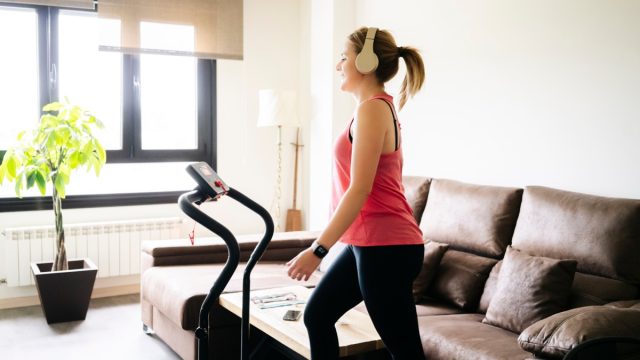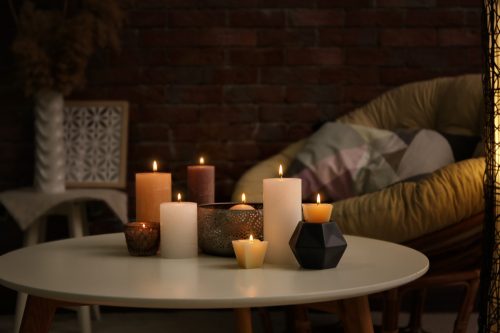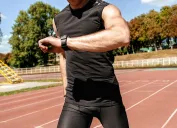Cozy Cardio Is the Latest Wellness Trend Everyone's Talking About
It can help you get moving and enjoy exercising, experts say.

Breaking a sweat in a workout class is something lots of fitness enthusiasts enjoy—but that experience isn't universal. In fact, many of us dread going to a gym, whether out of fear of being judged for our fitness level or because we don't want to shell out for a membership. If you're not interested in the gym and haven't found a workout that really makes you feel good on the inside and outside, you might want to give "cozy cardio" a go. Read on to find out what the latest wellness trend entails, and how you can get started.
RELATED: Silent Walking Is the Latest Wellness Trend Everyone's Talking About.
What is cozy cardio?
"Cozy cardio" picked up steam on social media after TikToker Hope Zuckerbrow posted her routine on the app. In her videos, she sets the "cozy" vibes with candles and ambient lighting and sets up her workout station, which includes a stand for her water and protein coffee beside her walking pad. She then warms up while choosing what to watch on TV, ups the speed on the walking pad for the majority of the 40-minute workout, and wraps up with a cooldown.
In an Aug. 7 TikTok video, Zuckerbrow explains she started cozy cardio to heal her own relationship with exercise, which later manifested into a form of meditation. In general, she wants cozy cardio to be a type of exercise that doesn't feel like a punishment, especially for women, who feel pressure from society to "look a certain way."
"Unlike traditional cardio workouts that are often intense and focused on burning lots of calories, cozy cardio allows you to take a more relaxed and holistic approach to exercise," Rachel MacPherson, certified strength and conditional specialist (CSCS), certified personal trainer (CPT), and author at Garage Gym Reviews, tells Best Life. "I feel it's become a popular exercise method because it feels less like punishment or 'work' and more like an enjoyable, soothing experience that fosters movement without the negativity or pressure of trying to conform your body to a certain standard. This is one reason Hope started exercising this way."
RELATED: Why Walking Only 3,867 Steps a Day Is All You Need, Science Says.
It can help kickstart a wellness routine.

As Zuckerbrow explains, cozy cardio helps set time aside to enjoy movement again—and if you find you like doing it, you're inclined to do it more often.
"Cozy cardio gets you your exercise in an enjoyable, gentler way, which could lead to you sticking with a movement routine," Rebecca Stewart, CPT, pain-free performance and mobility specialist, tells Best Life.
Rachel Lovitt, CPT, holistic movement coach, echoes this, noting that cozy cardio can help with "exercise initiation and consistency."
"When something is comfortable and you feel good during and after, you're more likely to do it and stick with it! I think it makes cardio feel more like self-care (which it is) and less like a punishment," she explains.
Lovitt continues, "Creating a specific environment, like lighting candles, putting on the same clothes, etc. also helps ready your mind and body for what's about to happen. In the same way that you shouldn't do work in your bed so that your body only associates your bed with sleep, you can create an environmental cue so as soon as you light that candle, your body knows that cardio is about to happen and will be more prepared."
You can do it from home.

According to Gina Newton, NASM-CPT, holistic body coach, cozy cardio has an added benefit because it's done in your own space in the comfort of your home.
"No rushing to get to a class … you may not be motivated to be at anyway," she says. "It is fairly gentle in that it isn't adding stress to your body! You can't make it to the gym? Opt for a cozy cardio workout."
Even better, if you find that you don't like the gym because it's overwhelming, cozy cardio is a sensory-friendly alternative.
"Many people find gyms intimidating and loud, [and they] might be over-stimulated by the bright lighting and swarms of people," Stewart says. "You can adapt cozy cardio to your needs by creating a comfortable space at home, whether that includes candles, LED lights, loose-fitting clothing, or your favorite rom-com … Another benefit of cozy cardio is that it can be done on your own time."
RELATED: 11 Calorie-Burning Activities That Don't Feel Like Exercise.
Try it for yourself.

As Stewart notes, cozy cardio is adaptable—and that includes the atmosphere you create, the activity you do, and when you do it.
"Try it for yourself by using a walking pad in your home like Zuckerbrow does, or try marching in place, pacing your home, or doing light aerobic activity, mobility work, yoga, or stretching," MacPherson says. "You can incorporate it by doing it in the evening to wind down before bed or during a work break if you work from home. You can also use it as a cool-down routine for more intense exercises, which will help regulate your nervous system and let you return to a calm state after a more excited one, improving recovery, sleep, and stress levels."
Of course, you also need to set the comfy mood—and as Zuckerbrow says, "cozy looks different for everyone."
"Figure out what things will help you feel cozy and comfortable," Lovitt says. "Maybe it's lighting a pumpkin spice candle. Maybe it's wearing your softest sweatpants. Maybe it's putting up some fairy lights. Many people love to pick one or more cozy items for all five senses. Once you set up your cardio station in your cozy environment, you're ready to go!"
When it comes to how often to do cozy cardio, that will again depend on your fitness goals, but Stewart recommends 20 minutes of cardio a day or 30 minutes five days a week.
There are a few other factors to consider.

While it's a great way to get you moving, experts caution against relying solely on cozy cardio for exercise. A walking pad or a treadmill can be expensive—and if you're doing it inside at home, you're not getting any fresh air. (Stewart notes that if the weather is nice, you can "take your cozy cardio outside by putting on some comfy sweats and your headphones with your favorite podcast, audiobook, or playlist.") In addition, Lovitt points out that your body eventually adapts and gets used to the workouts you do.
"This is a super cool part of your body, but it also means that in order to achieve the same benefits over time you have to increase the intensity which could be difficult in this setting," she says.
She recommends starting with a 15- to 20-minute walk and then gradually increasing the time and speed one at a time or simultaneously "as your body adapts to the challenge."
Josh York, founder and CEO of GYMGUYZ, shares that being uncomfortable is a crucial component of "seeing progress in your fitness." So, if you're looking for a more intense workout or different results, you might want to incorporate other elements into your routine. However, this can still be accomplished by wearing cozy clothes, he says. If you have the option to walk on your treadmill on an incline, you can easily "bring up your heart rate and add in a little extra burn" while still in your sweats.
MacPherson recommends incorporating resistance training—which you can still do at home—at least twice per week and "sprinkling in high-intensity bouts of movement for overall health and well-being, including metabolism, heart health, metabolic health, strength, stability, and reduced risks of injury, illness, and disease."
For more fitness advice delivered straight to your inbox, sign up for our daily newsletter.





















